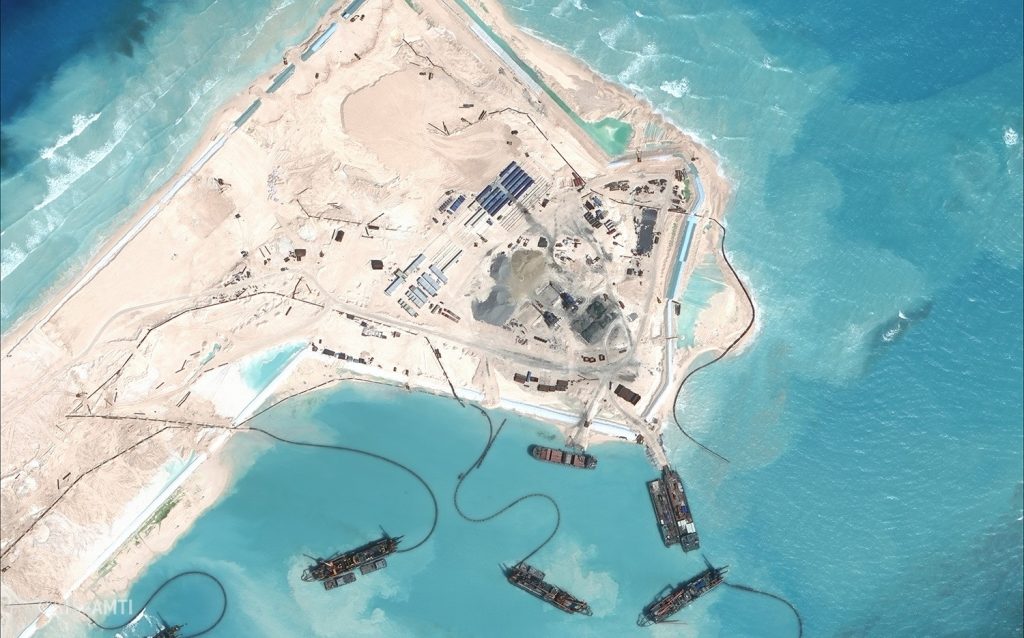 By Norman Friedman*
By Norman Friedman*
IN MAY, the Chinese continued their program of creating ‘facts on the ground’ by building airstrips and small bases atop the disputed reefs and islets of the South China Sea. At the same time other governments have taken their claims for the same islets and reefs to a United Nations tribunal which, in theory, adjudicates issues under the Law of the Sea treaty. It is widely expected that the court will declare the Chinese operations illegal – and that the Chinese will ignore its decision.
 International law is no stronger than the willingness of the parties involved to accept a court’s decisions. In contrast to national or local law, international law has no police force to enforce it. The Chinese government has shown no particular willingness to accept the rule of law as it is understood in the West – that is, to accept that it must submit to the will of an independent court. That attitude has become, if anything, more obvious over the past year or so as President Xi Jinping has cemented his power. He has used Chinese tribunals to attack his enemies, but anyone trying to use the same courts to demand rights guaranteed (in theory) by the Chinese government has been crushed.
International law is no stronger than the willingness of the parties involved to accept a court’s decisions. In contrast to national or local law, international law has no police force to enforce it. The Chinese government has shown no particular willingness to accept the rule of law as it is understood in the West – that is, to accept that it must submit to the will of an independent court. That attitude has become, if anything, more obvious over the past year or so as President Xi Jinping has cemented his power. He has used Chinese tribunals to attack his enemies, but anyone trying to use the same courts to demand rights guaranteed (in theory) by the Chinese government has been crushed.
The Chinese claim of ownership goes back to the end of World War II, and to a ‘nine-dash line’ drawn by the victorious allies around an area in the South China Sea. At that time the Western Allies accepted China as a full partner and a major contributor to Pacific victory. Of the countries now disputing Chinese claims, Vietnam was a French colony and the Philippines an American possession. Malaysia was British Malaya. Thailand was a former Japanese ally, nearly treated as a conquered enemy. Western governments ceased to enforce Chinese claims once the Communists won the Civil War in 1949, and the politics of the region bears little resemblance to what it was in 1945. The Law of the Sea treaty has completely changed the meaning of littoral waters and their ownership, and the sea can be seen as the intersection of the Exclusive Economic Zones of all the states bordering it. Under those circumstances it is rather difficult to see the South China Sea as anyone’s exclusive possession.
The stakes in the South China Sea are considerable. Americans tend to see a Chinese determination to run us out of South Asian waters so that China can dominate her neighbors – the Philippines, Vietnam, Thailand, and Malaysia in particular. The Chinese currently justify their bases in the South China Sea on the ground that they are merely replies to a threat raised by the United States when it established bases in the Philippines, but it is difficult to see how such bases fit that explanation. They are much more obviously a means of expressing and enforcing Chinese sovereignty over waters currently considered international. American bases in the Philippines do add to a U.S. ability to deal with China in the event of war, but small airstrips in the disputed area are unlikely to have much impact on attacks mounted from the Philippines, or indeed from U.S. naval forces.
The small bases are much more likely to support Chinese coast guard units enforcing sovereignty in the areas most important to the neighboring states: fisheries, the free passage of shipping, and possible exploitation of seabed resources, particularly oil. The South China Sea is already a major fishery, hence a major source of protein to the countries around it. As the most populous of the countries bordering the South China Sea, China needs more protein than the others, and it might be argued that the Chinese are trying to squeeze out the others. For some time a quiet coast guard competition has been brewing in the area; the Chinese are more willing to use coast guards than warships because they do not raise the same degree of alarm. Typically it is coast guard ships, not warships, which enforce fishing restrictions and rights.
For years it has been assumed that the South China Sea is a major untapped source of oil. As long ago as the Vietnam War the U.S. government deliberately avoided allowing U.S. companies to drill in the area for fear that opponents of the war would argue that it was being prosecuted only to gain access to oil. More recently exploratory wells have been sunk, apparently with little success. However, the geological evidence still points to oil. China needs immense amounts of oil, and as her economy modernizes she will need even more. Attempts to tap supposed resources in Western China (Sinkiang) have not been particularly successful. China therefore depends heavily on Siberian oil and on Middle Eastern oil, neither of which she controls. Compared to either, oil fields in the South China Sea would be extremely attractive, and access to them would be relatively easy to defend. The islet and reef bases would be rather valuable in that case.
For Chinese President Xi, there are vital political stakes in the South China Sea dispute. He is attempting to cement his rule at a particularly difficult time. For years his Chinese Communist Party has made two arguments to justify its rule. One is that only the Party can keep China strong and prevent humiliations like those of the past. This argument often translates into strong Chinese nationalism and into the attitude that China must never again withdraw in the face of foreign pressure – like a decision by the United Nations tribunal.
The second argument justifying the Party’s rule is that only the Party can keep China strong – meaning prosperous. Unfortunately the Party has shown little understanding of market economics. Many of its senior officials, such as Xi himself, have received economic training in the West, but that does not amount to an instinctive understanding of markets and their impacts. A Party which considers itself above the rule of law also considers itself above the petty limits of market economics. For example, the Party has sought to maintain peace inside China by underwriting government companies running at a considerable loss. Visitors to China see the result in empty office buildings which look impressive but cannot pay back the money provincial governments borrowed to pay for them. The Party looks back toward a command economy which it could fully control.
The Party’s economic problem is unlikely to be solved. Capitalism – a free market economy – generates growth and overall prosperity at a high social cost, in what is called ‘creative destruction.’ Industries which were once prosperous, and which provided many jobs, later find themselves shrinking drastically, throwing many workers out of their security and their jobs. The West has managed to live with this kind of economics partly by providing a social safety net and partly simply by having enough political resilience to survive the anger of those who lose their jobs. Recent anger in both the United States and Europe over what amounts to rapid economic change (and hence destruction) is testimony to how strong the effect of ‘creative destruction’ can be.
A one-party state is poorly adapted to deal with this kind of pressure. Attempting to cope with the Chinese financial crisis, Mr. Xi and his Party have had to accept (or even cause) massive unemployment. A partial safety net in the form of cash payments and retraining is unlikely to solve the problem, not least because for either to work the government has to be able to predict what sorts of jobs the future Chinese economy will need, and where they will be. Had it been able to do so, it would not be in its current difficulties. The unitary Party cannot really afford flexibility, because that would bring its wisdom, hence the justification for its rule, into question.
To make matters worse, Mr. Xi seems determined to increase rather than relax Party control in China. He is building both a cult of personality (like Mao’s) to keep himself in power and a more doctrinaire Party; he insists that the Party intensify its propaganda and make increasing efforts to keep out Western ideas. Just how well any of that can work is questionable; too many Chinese have spent too much time abroad, and in general the Chinese population is considerably more sophisticated than in the past. The main success of the propaganda push has probably been to suppress discussion of the 1989 demonstrations, culminating in the massacre in Tien An Men Square in Beijing, which seemed poised to open Chinese politics.
All of this means that the main surviving justification for Communist Party rule is that the Party is keeping China strong and resisting humiliation. It seems most unlikely that a government which has painted itself into such a position will or even can retreat on the South China Sea question. The Party – and Mr. Xi — just cannot afford any retreat. Moreover, it seems unlikely that Mr. Xi will ever feel secure enough to change this orientation. The Party cannot censor news of any Chinese accommodation even if it wants to. Ironically, the degree of openness in China, which would otherwise be very welcome, is likely to make Chinese foreign policy significantly more rigid.
In a larger sense, if the UN tribunal rules against China and is ignored, the entire structure of the Law of the Sea Treaty may well begin to collapse. The treaty has generally been sold as the basis for peaceful exploitation of seabed resources. The argument made in the United States in favor of the treaty has been that regularizing access to the seabed will be of immense benefit to the United States, which is one of very few countries with the technology needed to mine the seabed. Anarchy is very bad for such business, since no potential investor will risk money without some guarantee of security.
The seabed can still be policed, but on a basis more like the colonial operations of the past, with armed security provided by whichever country is going the drilling or mining. At the very least, that would mean a boom in coast guard and probably naval forces. It may also mean naval warfare to secure access to prized resources, something which has not seemed likely for many years.
* Norman Friedman is author of The Naval Institute Guide to World Naval Weapon Systems. His column is published with kind permission of the US Naval Institute.



